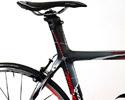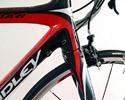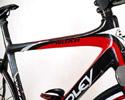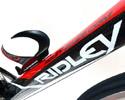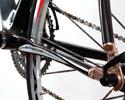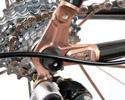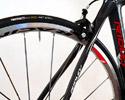
Recently on Cyclingnews.com |
On test: Ridley Noah, August 8, 2007
Quick to the line

|
Ridley created its new Noah almost exclusively for the needs of its star sprinter, Robbie McEwen (Predictor-Lotto). How well does it satisfy those specific needs, and how well does it serve as an all-around machine? Cyclingnews Tech Editor James Huang makes a mad dash for the line to see for himself.
Belgium-based Ridley Bicycles has only been around since 1990 yet has been quick to create a name for itself, particularly in its European home theatre. Tom Boonen won the Belgium Espoir road championship aboard one in 2001, and carbon X-night 'cross bikes were first across the line at the 2003 and 2006 Cyclo Cross World Championships under Bart Wellens and Erwin Vervecken (Fidea), respectively. The Ridley-sponsored Predictor-Lotto team brought home even more success at this year's Tour de France, with a second place overall by Cadel Evans and a brilliant come-from-behind Stage 1 victory by fellow Aussie Robbie McEwen.
Build it for Robbie
With that sort of firepower, it's no surprise that Ridley would cater specifically to its racers when it debuted the Noah at last year's TdF. The new model was developed as a successor to the company's Damocles model in response to its racers' requests (in particular those of sprinter McEwen) to make it "as stiff as possible." Carbon content on the monocoque Noah has been upgraded to stiffer and stronger fibers relative to the Damocles, and reinforced with Kevlar in critical impact areas to offset the fibers' more brittle nature.
The Noah retains the tapered and oversized 1 1/8"-to-1 1/2" steerer tube of the Damocles, which provides improved stiffness and strength over standard 1 1/8" setups, as well as the general styling of its 'switching triangular form' main triangle which Ridley claims provides additional rigidity over round tubes. The most obvious departures, however, are the substantially beefier head tube area and the newly integrated seatpost mounted atop a radically deeper seat tube.
The seat tube maintains its section profile from the saddle all the way down to the bottom bracket, which not only supposedly offers improved aerodynamics (the rear wheel is also partially shielded by a shallow cutout in the tube) but also reinforces the bottom bracket against unwanted flex. Ridley boldly claims that the design is fully 50% stiffer than a conventional oversized tube design.
The rear end of the Noah is similar to the Damocles with more 'switching triangular form' tubes and monostay connections at the bottom bracket shell and seat tube. Fully replaceable CNC-machined titanium dropouts provide a robust platform for the rear derailleur for better shifting performance, and at the same time are also rather thin to facilitate wheel changes. The full-carbon monocoque straight-bladed fork is carried over from the Damocles.
All of this stiffness does come at a price, however: our small-sized test frame weighed 1380g (3.04lb) with an uncut seatpost (but without the relatively bulky seatpost head), and the somewhat oddly eclectic build kit didn't help, either. Our tester was fitted with top-end Campagnolo Record Ergopower shifters, derailleurs, and brake calipers, but a mid-level Campagnolo Chorus steel cassette, and FSA's Team Issue crankset.
Further confusion was produced by the mid-range Fulcrum Racing 3 clincher wheelset shod with wire bead Vredestein Fortezza tires (wire beads? Are you kidding?) and a downright homely Selle San Marco Ponza boat anchor which, as it turns out, is the same saddle included with the bargain basement US$525 Schwinn Madison fixie we reviewed a few months back. Ridley's 4ZA house brand rounded things out with a bonded carbon-and-aluminum stem, Fynisher carbon handlebar, and intriguing bottle cage.
Complete weight as tested was a fairly unimpressive 7.8kg (17.2lb), although to be fair, our Noah could probably be a full kilo lighter with a more reasonable set of components. Suggested retail for the frameset is US$3150, while our test bike, would fetch about US$5999 as built.
Hacking away
For just about any integrated seat mast design (with Trek's new Madone being perhaps the lone exception), the prime concern for any new owner is, quite understandably, having to rather violently lop off the top of their carbon fiber wündermachine to suit their saddle height. To add insult to injury, this is usually done with a lowly hacksaw, a decidedly primitive invention that really hasn't changed little since its invention sometime in the Mesozoic era. 'Nice' hacksaws are typically in the range of US$35 or so (including a blade!), or roughly the asking price of the 4ZA bottle cage mounted on our Noah, and sadly, a quick search yielded nary a single offering in carbon fiber. And we're supposed to do what with this? *sigh*
Regardless, Ridley provides a handy clamp-on cutting guide to assist in making a straight cut, the accuracy of which is still largely dependent on your own ability to measure eight bazillion times, and then cut once. The unfortunate truth of the matter is that cutting too little is easy enough to fix, but cutting too much will earn the frame a one-way trip to eBay if the 18mm of additional seat adjustment doesn't suffice. Probably best not to be enjoying your favorite alcoholic beverage this time around, and perhaps lay off the coffee while you're at it, too. This is an act best served by a clear mind and calm nerves.
Once the deed was done, building up the rest of our test was a routine affair. Some thoughtful touches stood out during assembly, not the least of which are the clever derailleur housing guide tubes molded into the bottom of the head tube. These not only make for a cleaner appearance, but also eliminate housing rub that would inevitably mar the Noah's otherwise striking paint job. Cable routing was clean and direct overall (and gloriously external, thank you very much).
Why am I speaking with this Aussie accent all of a sudden?
After spending some time on the Noah, it's no wonder how McEwen is able to hit the finish line with such ferocity (and people think it's the legs; ha!). If Ridley's aim was to make a stiff and fast machine for its Aussie star, we'd have to unequivocally agree that it hit the mark as the Noah displays drivetrain stiffness easily on par with the best we've tested to date. Power delivery is immediate and efficient when sprinting out of the saddle, but also just when you're cruising on the flats and want to kick things up a notch or two. The impressive torsional stiffness also aids out-of-saddle efforts with virtually no out-of-plane motion detected between the front and rear to knock the Noah out of line.
We've already mentioned our tester's relative heft, but this was offset somewhat by the Noah's overwhelming rigidity when the road pointed upwards. The beefy drivetrain and front triangle that were so welcome in town line sprints also made the Noah a surprisingly capable climber, in spite of the extra weight and decidedly flatlander gearing.
The solid chassis continues to pay dividends on the way back down with precise steering and surefooted handling, likely aided in no small part by the oversized and tapered fork and Biggie-sized head tube area (mmm…French fries). The Noah's demeanor is certainly quick as befitting its role as a sprinter's bike, but its reassuring predictability tends to counter any twitchiness we'd otherwise expect, especially at higher speeds. While we wouldn't use 'stable' as the primary descriptor for the Noah, it still passes the 'peel a banana' test nicely.
Much as that stiffness yields some extra mass, though, the Noah's admirable efficiency also comes somewhat at the expense of ride quality. Vredestein recommends that its tires be run at 145psi, but we found the Noah virtually unrideable at that setting and ended up settling on a more reasonable 110psi front and rear. The Noah damps smaller amplitude road buzz rather nicely at those pressures, but crashes violently over medium and large impacts with little compliance to speak of. Part of the blame is probably attributable to the deep-profile integrated seatpost which flexes about as much as a cast iron safe, but little about the frame's design in general suggests much in the way of comfort.
To be fair, this is exactly how most ProTour riders seem to like their rides from what we've gathered and, again, Ridley's goal for the Noah was giving their sponsored athletes exactly what they asked for. This is not to say that the Noah is a racer-only bike, but those seeking a cushy all-day couch should probably expand their search before laying down the plastic.
We're also still undecided on the integrated seat mast design. In this case, the purported benefit of lighter weight doesn't really pan out, but it almost certainly provides a stiffer platform than more typically-sized conventional seatposts. Still, the design precludes packing the Noah in a travel case and also has a profoundly negative impact on resale value with its limited height adjustment. It does look awfully cool, however…
Parts is parts
Our build kit performed mostly as expected, with dependable (if unremarkable) performance throughout the test period with few exceptions. The Fulcrum Racing3 wheelset is quite weighty at over 1600g for the pair, yet proved responsive and held their speed well, while Campy's Record and Chorus componentry served admirably with nary a complaint.
Our experience with Ridley's house-brand 4ZA bits was more of a mixed bag, however. The bonded carbon fiber-and-aluminum stem didn't do anything wrong, but we have yet to come across a stem of that type that provided any tangible performance benefits over a well-designed one-piece aluminum one. We were also never able to come to grips with the rather contrived bends of the 4ZA Fynisher carbon-and-aluminum handlebar, particularly with the downward slope it takes as it exits the stem. After two rides, we ended up swapping it for a Deda model.
The 4ZA Tail bottle cage was a pleasant surprise, however. We didn't expect much from its spindly construction and simple shape, but it proved to reliably hold bottles even on rough roads while offering ultra-smooth entry and exit.
Will the Noah make you faster?
If your own personal goal is simply getting to your preferred finish line (be it real or imaginary) faster, then the answer is almost certainly 'yes'. The Noah is brutally efficient in its purpose as a full-on race machine, and will probably satisfy those looking for such a beast. Still, the Noah probably still needs to shed a few grams to make it truly competitive among some of its more notable competition, and some refinement in its ride quality wouldn't exactly hurt, either.
Nonetheless, the Noah is clearly happiest at warp speed and then some; treat it rough and muscle it around a bit (as it seems to like it that way) and you will be duly rewarded. Noodle around town on it as a coffee-getter, though, and it will offer little other than a stiff ride, snazzy looks, and spilt coffee.
Price: US$5999 (as tested); US$3150 (frameset only)
Weight: 7.8kg (17.2lb) (without pedals)
Pros: Fantastically efficient chassis, excellent handling characteristics,
drop-dead gorgeous lines, integrated seatpost
Cons: Stiff ride quality may not suit all, passable 4ZA handlebar and
stem, integrated seatpost
Cyclingnews rating: ![]()
More information: www.ridley-bikes.com, www.4za.info
Photography
For a thumbnail gallery of these images, click here
Images by James Huang/Cyclingnews.com
- The Ridley Noah is purpose-built as a full-on race machine.
- Striking lines and beautiful paint mark Robbie McEwen's weapon of choice.
- The Noah's most defining feature is the integrated seatpost and deep-profile aerodynamic seat tube.
- A short cutout in the seat tube partially shields the rear wheel.
- As compared to the Damocles , the Noah features a decidedly beefier head tube area.
- The Noah frameset includes a full-carbon monocoque fork with straight blades.
- The Noah's 'switching triangular form' frame includes a top tube that starts out with a triangular cross-section at the head tube which transitions to a diamond shape at the seat tube.
- The down tube is similarly profiled with a triangular cross-section at the head tube and diamond-shaped one at the bottom bracket.
- The radically shaped chain stays are built to combat rear end flex.
- The chain stays start out round at the dropouts and end up distinctly triangular at the bottom bracket.
- CNC-machined titanium dropouts offer the same peace of mind as a replaceable derailleur hanger but without the usual shift-degrading flex.
- Relatively slender seat stays provide a margin of comfort.
- The aluminum seatpost head offers 18mm of saddle height adjustment.
- The cleverly designed seatpost head offers both straight and offset positions, although the adjusting bolt can be difficult to access depending on the saddle used.
- Not surprisingly, the Noah wears a lot of carbon at the bottom bracket.
- The 4ZA Fynisher bar is intended to be hyper-anatomic, but we never fully got along with its somewhat odd shape.
- The drops are comfortable enough, though.
- The 4ZA C-Stem bonds a carbon fiber center tube to aluminum ends.
- FSA's mid-level Team Issue crankset isn't its lightest, but can be easily upgraded to SRM functionality.
- Campagnolo's Record Ergopower levers rattled off dependable shifts.
- Rear changes are handled by a Campagnolo Record rear derailleur.
- The position of the braze-on front derailleur mount looks to allow for both standard and compact drivetrains.
- Campagnolo's Record D-Skeleton brakes provided dependable stopping power.
- The single pivot rear brake is lighter and less prone to lockup, according to Campagnolo.
- Excess material is milled away from in between the spokes to reduce weight without compromising spoke pull-through strength.
- Fulcrum uses twice as many spokes on the driveside as on the non-driveside to help equalize spoke tension.
- Vredestein tires on our tester were shockingly entry-level with wire beads!
- What on earth is this saddle doing on this bike?!
- The 4ZA Tail bottle cage doesn't look up to the task, but held on to bottles even in rough conditions.
Full specification: Ridley Noah
|
Frame Ridley Noah, T700 high modulus carbon with CNC-machined
titanium dropouts |
Cassette Campagnolo Chorus 12-23 |

